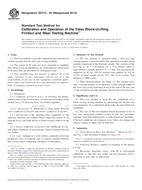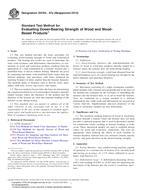Potrebujeme váš súhlas na využitie jednotlivých dát, aby sa vám okrem iného mohli ukazovať informácie týkajúce sa vašich záujmov. Súhlas udelíte kliknutím na tlačidlo „OK“.
ASTM D4633-10
Standard Test Method for Energy Measurement for Dynamic Penetrometers
Automaticky preložený názov:
Štandardná skúšobná metóda pre meranie energie pre dynamické penetrometre
NORMA vydaná dňa 1.1.2010
Informácie o norme:
Označenie normy: ASTM D4633-10
Poznámka: NEPLATNÁ
Dátum vydania normy: 1.1.2010
Kód tovaru: NS-27967
Počet strán: 7
Približná hmotnosť: 21 g (0.05 libier)
Krajina: Americká technická norma
Kategória: Technické normy ASTM
Kategórie - podobné normy:
Anotácia textu normy ASTM D4633-10 :
Keywords:
energy, liquefaction, N-value, penetrometer, SPT, standard penetration test, Liquefaction, Penetrometer testing, Sampling, Soil, SPT (standard penetration test), ICS Number Code 93.020 (Earthworks. Excavations. Foundation construction. Underground works)
Doplňujúce informácie
| Significance and Use | ||||||||||
|
Various driven in situ penetrometers are used to evaluate the engineering behavior of soils. The Standard Penetration Test is the most common type. Engineering properties can be estimated on the basis of empirical correlations between N-values and soil density, strength or stiffness. Alternatively, the N-value can be used directly in foundation design using correlations to design parameters such as allowable bearing pressure or pile capacity. The N-value depends on the soil properties but also on the mass, geometry, stroke, anvil, and operating efficiency of the hammer. This energy measurement procedure can evaluate variations of N-value resulting from differences in the hammer system. See also Refs (1-6). There is an approximate, linear relationship between the incremental penetration of a penetrometer and the energy from the hammer that enters the drill rods, and therefore an approximate inverse relationship between the N-value and the energy delivered to the drill rods. Note 1—Since the measured energy includes the extra potential energy effect due to the set per blow, tests for energy evaluation of the hammer systems should be limited to moderate N-value ranges between 10 and 50 (Ref (7)). Stress wave energy measurements on penetrometers may evaluate both operator-dependent cathead and rope hammer systems and relatively operator-independent automatic systems. The energy measurement has direct application for liquefaction evaluation for sands as referenced in Practice D6066. This test method is useful for comparing the N-values produced by different equipment or operators performing SPT testing at the same site, aiding the design of penetrometer systems, training of dynamic penetrometer system operators, and developing conversion factors between different types of dynamic penetration tests. Note 2—The quality of the result produced by this standard is dependent on the competence of the personnel performing it, and the suitability of the equipment and facilities used. Agencies that meet the criteria of Practice D3740 are generally considered capable of competent and objective testing and inspection. Users of this standard are cautioned that compliance with Practice D3740 does not in itself assure reliable results. Reliable results depend on many factors: Practice D3740 provides a means of evaluating some of those factors. |
||||||||||
| 1. Scope | ||||||||||
|
1.1 This test method describes procedures for measuring the energy that enters the penetrometer drill rod string during dynamic penetrometer testing of soil due to the hammer impact. 1.2 This test has particular application to the comparative evaluation of N-values obtained from the Standard Penetration Tests (SPT) of soils in an open hole as in Test Method D1586 and Practice D6066. This procedure may also be applicable to other dynamic penetrometer tests. 1.3 The values stated in SI units are to be regarded as standard. The inch-pound units given in parentheses are mathematical conversions which are provided for information purposes only and are not considered standard. 1.4 Limitations—This test method applies to penetrometers driven from above the ground surface. It is not intended for use with down-hole hammers. 1.5 All observed and calculated values shall conform to the guidelines for significant digits and rounding established in Practice D6026. 1.6 The method used to specify how data are collected, calculated, or recorded in this standard is not directly related to how the data can be applied in design or other uses, since that is beyond its scope. Practice D6066 specifies how these data may be normalized. 1.7 This standard does not purport to address all of the safety concerns, if any, associated with its use. It is the responsibility of the user of this standard to establish appropriate safety and health practices and determine the applicability of regulatory limitations prior to use. |
||||||||||
| 2. Referenced Documents | ||||||||||
|
Podobné normy:
Historická
1.5.2014
Historická
1.1.2010
Historická
1.5.2014
Historická
1.4.2008
Historická
1.4.2012
Historická
1.4.2013
Odporúčame:
EviZak - všetky zákony vrátane ich evidencie na jednom mieste
Poskytovanie aktuálnych informácií o legislatívnych predpisoch vyhlásených v Zbierke zákonov od roku 1945.
Aktualizácia 2x v mesiaci !
Chcete vedieť viac informácii ? Pozrite sa na túto stránku.



 ASTM D2714-94(2014)..
ASTM D2714-94(2014).. ASTM D3580-95(2010)..
ASTM D3580-95(2010).. ASTM D3702-94(2014)..
ASTM D3702-94(2014).. ASTM D5277-92(2008)..
ASTM D5277-92(2008).. ASTM D5748-95(2012)..
ASTM D5748-95(2012).. ASTM D5764-97a(2013)..
ASTM D5764-97a(2013)..
 Cookies
Cookies
